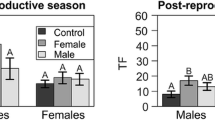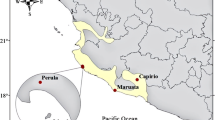Abstract
In many animals, chemical signals play an important role in species recognition and may contribute to reproductive isolation and speciation. The Iberian lizards of the genus Podarcis, with up to nine currently recognized lineages that are often sympatric, are highly chemosensory and provide an excellent model for the study of chemically mediated species recognition in closely related taxa. In this study, we tested the ability of male and female lizards of two sister species with widely overlapping distribution ranges (Podarcis bocagei and P. hispanica type 1) to discriminate between conspecific and heterospecific mates by using only substrate-borne chemical cues. We scored the number of tongue flicks directed at the paper substrate by each individual in a terrarium previously occupied by a conspecific or a heterospecific lizard of the opposite sex. Results show that males of P. bocagei and P. hispanica type 1 are capable of discriminating chemically between conspecifics and heterospecifics of the opposite sex, but females are not. These results suggest that differences in female, but not male, chemical cues may underlie species recognition and contribute to reproductive isolation in these species. The apparent inability of females to discriminate conspecific from heterospecific males, which is not because of reduced baseline exploration rates, is discussed in the context of sexual selection theory and species discrimination.

Similar content being viewed by others
References
Alberts, A. C. 1991. Phylogenetic and adaptative variation in lizard femoral gland secretions. Copeia 1991:69–79.
Barbosa, D., Desfilis, E., Carretero, M. A., and Font, E. 2005. Chemical stimuli mediate species recognition in Podarcis wall lizards. Amphib-Reptil. 26:257–263.
Bininda-Emonds, O. R. P., Decker-Flum, D. M., and Gittleman, J. L. 2001. The utility of chemical signals as phylogenetic characters: an example from Felidae. Biol. J. Linn. Soc. 72:1–15.
Blumstein, D. T., Evans, C. S., and Daniel, J. C. 2000. JWatcher version 0.9. Animal Behaviour Lab., Macquarie University, Sydney.
Butlin, R. K. and Ritchie, M. G. 1994. Behaviour and speciation, pp 43–79, in P. J. B. Slater and T. R. Halliday (eds.). Behaviour and Evolution. Cambridge University Press, Cambridge.
Cooper, W. E., Jr. 1998. Evaluation of swab and related tests as a bioassay for assessing responses by squamate reptiles to chemical stimuli. J. Chem. Ecol. 24:841–866.
Cooper, W. E., Jr. and Burghardt, G. M. 1990. A comparative analysis of scoring methods for chemical discrimination of prey by squamate reptiles. J. Chem. Ecol. 16:45–65.
Cooper, W. E., Jr. and Garstka, W. R. 1987. Lingual responses to chemical fractions of urodaeal glandular pheromone of the skink Eumeces laticeps. J. Exp. Zool. 242:249–253.
Cooper, W. E., Jr. and Pérez-Mellado, V. 2002. Pheromonal discrimination of sex, reproductive condition, and species by the lacertid lizard Podarcis hispanica. J. Exp. Zool. 292:523–527.
Cooper, W. E., Jr. and Vitt, L. J. 1984. Detection of conspecific odors by the female broad-headed skink, Eumeces laticeps. J. Exp. Zool. 229:49–54.
Cooper, W. E., Jr. and Vitt, L. J. 1986a. Thermal dependence of tongue-flicking and comments on the use of tongue-flicking as an index of squamate behavior. Ethology 71:177–186.
Cooper, W. E., Jr. and Vitt, L. J. 1986b. Tracking female conspecific odor by trails by male broad-headed skinks (Eumeces laticeps). Ethology 71:242–248.
Cooper, W. E., Jr. and Vitt, L. J. 1987. Ethological isolation, sexual behavior and pheromones in the Fasciatus species group of the lizard genus Eumeces. Ethology 75:328–336.
de Queiroz, A. and Wimberger, P. H. 1993. The usefulness of behavior for phylogeny estimation: levels of homoplasy in behavioral and morphological characters. Evolution 47:46–60.
Desfilis, E., Font, E., and Guillén-Salazar, F. 2003. Stimulus control of predatory behavior by the Iberian wall lizard (Podarcis hispanica, Sauria, Lacertidae): effects of familiarity with prey. J. Comp. Psychol. 117:309–316.
Dial, B. E. and Schwenk, K. 1996. Olfaction and predator detection in Coleonyx brevis (Squamata: Eublepharidae), with comments on the functional significance of buccal pulsing in geckos. J. Exp. Zool. 276:415–424.
Eady, P. E. 2001. Postcopulatory, prezygotic reproductive isolation. J. Zool. 253:47–52.
Font, E. and Desfilis, E. 2002. Chemosensory recognition of familiar and unfamiliar conspecifics by juveniles of the Iberian wall lizard Podarcis hispanica. Ethology 108:319–330.
Gabe, M. and Saint-Girons, H. 1976. Contribution a la morphologie compareé des fosses nasales et de leur annexes chez les Lépidosauriens. Mem. Mus. Natl. Hist. Nat., Ser. A Zool. 98:1–87.
Galán, P. 1986. Morfología y distribución del género Podarcis Wagler, 1830 (Sauria, Lacertidae) en el noroeste de la Península Ibérica. Rev. Esp. Herpetol. 1:87–142.
Gittleman, J. L. and Decker, M. 1994. The phylogeny of behaviour, pp. 80–105, in P. J. B. Slater and T. R. Halliday (eds.). Behaviour and Evolution. Cambridge University Press, Cambridge.
Gómez, A., Font, E., and Desfilis, E. 1993. Chemoreception in the Lacertidae: exploration and conspecific discrimination in the Spanish wall lizard, Podarcis hispanica, pp. 213–230, in E. D. Valakos, V. Pérez-Mellado, and P. Maragou (eds.). Lacertids of the Mediterranean Region: A Biological Approach. Hellenic Zoological Society, Athens.
Greenberg, N. 1985. Exploratory behavior and stress in the lizard, Anolis carolinensis. Z. Tierpsychol. 70:89–102.
Halpern, M. 1992. Nasal chemical senses in reptiles: structure and function, pp. 423–523, in C. Gans and D. Crews (eds.). Hormones, Brain, and Behavior. Biology of Reptilia, Vol. 18 E. The University of Chicago Press, Chicago.
Hamilton, P. S. and Sullivan, B. K. 2005. Female mate attraction in ornate tree lizards (Urosaurus ornatus): a multivariate analysis. Anim. Behav. 69:219–224.
Harris, D. J. and Sá-Sousa, P. 2002. Molecular phylogenetics of Iberian wall lizard (Podarcis): is Podarcis hispanica a species complex? Mol. Phylogenet. Evol. 23:75–81.
Heth, G., Todrank, J., Busquet, N., and Baudoin, C. 2001. Odour-genes covariance and differential investigation of individual odours in the Mus species complex. Biol. J. Linn. Soc. 73:213–220.
Kaliontzopoulou, A., Carretero, M. A., and Llorente, G. A. 2005. Differences in pholidotic patterns of Podarcis bocagei and P. carbonelli and its implications for species determination. Rev. Esp. Herpetol. (in press).
Labra, A., Escobar, C. A., and Niemeyer, H. M. 2001. Chemical discrimination in Liolaemus lizards: A comparison of behavioral and chemical data, pp. 437–444, in A. Marchelewska-Koj, F. Lepri and D. Müller-Schwarze (eds.). Chemical Signals in Vertebrates 9. Kluwer Academic/Plenum Publishers, New York.
LeBas, N. R. and Marshall, N. J. 2001. No evidence of female choice for a condition-dependent trait in the agamid lizard, Ctenophorus ornatus. Behaviour 138:965–980.
LeMaster, M. P. and Mason, R. T. 2003. Pheromonally mediated sexual isolation among denning populations of red-sided garter snakes, Thamnophis sirtalis parietalis. J. Chem. Ecol. 29:1027–1043.
LeMaster, M. P., Moore, I. T., and Mason, R. T. 2001. Conspecific trailing behaviour of red-sided garter snakes, Thamnophis sirtalis parietalis, in the natural environment. Anim. Behav. 61:827–833.
López, P. and Martín, J. 2001. Pheromonal recognition of females takes precedence over the chromatic cue in male Iberian wall lizards Podarcis hispanica. Ethology 107:901–912.
Mas, F. and Jallon, J.-M. 2005. Sexual isolation and cuticular hydrocarbon differences between Drosophila santomea and Drosophila yakuba. J. Chem. Ecol. 31:2747–2752.
Mason, R. T. 1992. Reptilian pheromones, pp. 114–228, in C. Gans and D. Crews (eds.). Hormones, Brain, and Behavior. Biology of Reptilia, Vol. 18 E. The University of Chicago Press, Chicago.
Mason, R. T. 1993. Chemical ecology of the red-sided garter-snake, Thamnophis sirtalis parietalis. Brain Behav. Evol. 41:261–268.
Olsson, M. and Madsen, T. 1998. Sexual selection and sperm competition in reptiles, pp. 503–577, in T. R. Birkhead and A. P. Møller (eds.). Sperm Competition and Sexual Selection. Academic Press, San Diego.
Phelan, P. L. and Baker, T. C. 1987. Evolution of male pheromones in moths: reproductive isolation through sexual selection? Science 235:205–207.
Pinho, C., Harris, D. J., and Ferrand, N. 2003. Genetic polymorphism of 11 allozyme loci in populations of wall lizards (Podarcis sp.) from the Iberian Peninsula and North Africa. Biochem. Genet. 41:343–359.
Pinho, C., Ferrand, N., and Harris, D. J. 2006. Reexamination of the Iberian and North African Podarcis (Squamata: Lacertidae) phylogeny based on increased mitochondrial DNA sequencing. Mol. Phylogenet. Evol. 38:266–273.
Ptacek, M. B. 2000. The role of mating preferences in shaping interspecific divergence in mating signals in vertebrates. Behav. Processes 51:111–134.
Quinn, G. P. and Keough, M. J. 2002. Experimental Design and Data Analysis for Biologists. Cambridge University Press, Cambridge.
Roberts, J. A. and Uetz, G. W. 2004. Chemical signaling in a wolf spider: a test of ethospecies discrimination. J. Chem. Ecol. 30:1271–1284.
Rypstra, A. L., Wieg, C., Walker, S. E., and Persons, M. H. 2003. Mutual mate assessment in wolf spiders: differences in the cues used by males and females. Ethology 109:315–325.
Sá-Sousa, P. 2000. A predictive distribution model for the Iberian wall lizard (Podarcis hispanicus) in Portugal. Herpetol. J. 10:1–11.
Sá-Sousa, P. 2001. A controversa sistemática das lagartixas do género Podarcis Wagler, 1830 (Sauria, Lacertidae) em Portugal. Ph.D. dissertation. University of Lisbon, Lisbon.
Sá-Sousa, P., Vicente, L., and Crespo, E. G. 2002. Morphological variability of Podarcis hispanica (Sauria: Lacertidae) in Portugal. Amphib-Reptil. 23:55–69.
Schwenk, K. 1995. Of tongue and noses: chemoreception in lizards and snakes. Trends Ecol. Evol. 10:7–12.
Shine, R., Olsson, M. M., and Mason, R. T. 2000. Chastity belts in gartersnakes: the functional significance of mating plugs. Biol. J. Linn. Soc. 70:377–390.
Shine, R., Reed, R. N., Shetty, S., LeMaster, M., and Mason, R. T. 2002. Reproductive isolating mechanisms between two sympatric sibling species of sea snakes. Evolution 56:1655–1662.
Shine, R., Phillips, B., Waye, H., LeMaster, M., and Mason, R. T. 2003. Chemosensory cues allow courting male garter snakes to assess body length and body condition of potential mates. Behav. Ecol. Sociobiol. 54:162–166.
Siegel, S. and Castellan, N. J. 1988. Nonparametric Statistics for the Behavioral Sciences. McGraw-Hill Book Company, New York.
Steele, L. J. and Cooper, W. E., Jr. 1997. Investigations of pheromonal discrimination between conspecific individuals by male and female leopard geckos (Eublepharis macularius). Herpetologica 53:475–484.
Sutton, R., Bolton, E., Bartels-Hardege, H. D., Eswards, M., Reish, D. J., and Hardege, J. D. 2005. Chemical signal mediated premating reproductive isolation in a marine polychaete, Neanthes acuminata (arenaceodentata). J. Chem. Ecol. 31:1865–1876.
Symonds, M. R. E. and Elgar, M. A. 2004. The mode of pheromone evolution: evidence from bark beetles. Proc. R. Soc. Lond. B 271:839–846.
Tokarz, R. R. 1995. Mate choice in lizards: A review. Herpetol. Monogr. 9:17–40.
Verbeek, B. 1972. Ethologische Untersuchungen an einigen europäischen Eidechsen. Bonn. Zool. Beitr. 23:122–151.
Verrell, P. 2003. Population and species divergence of chemical cues that influence male recognition of female in desmognathine salamanders. Ethology 109:577–586.
Wyatt, T. D. 2003. Pheromones and Animal Behaviour: Communication by Smell and Taste. Cambridge University Press, Cambridge.
Acknowledgments
This work was financially supported by project POCTI/BSE/45664/2002 of Fundação para a Ciência e a Tecnologia (FCT, Portugal). D.B. was funded by a Ph.D. grant (SFRH/BD/14084/2003) and M.A.C. by a postdoctoral grant (SFRH/BPD/3596/2000), both also from FCT. We thank two anonymous reviewers for helpful advice and comments and R. Ribeiro, R. Vasconcelos, and D. J. Harris for helping in fieldwork. Animals were collected under permits provided by the Instituto da Conservação da Natureza (ICN, Portugal) and were maintained and treated in accordance with Spanish Law (Real Decreto 223/1988) and Animal Behavior Society Guidelines for the Treatment of Animals in Behavioral Research and Teaching.
Author information
Authors and Affiliations
Corresponding author
Rights and permissions
About this article
Cite this article
Barbosa, D., Font, E., Desfilis, E. et al. Chemically Mediated Species Recognition in Closely Related Podarcis Wall Lizards. J Chem Ecol 32, 1587–1598 (2006). https://doi.org/10.1007/s10886-006-9072-5
Received:
Revised:
Accepted:
Published:
Issue Date:
DOI: https://doi.org/10.1007/s10886-006-9072-5




